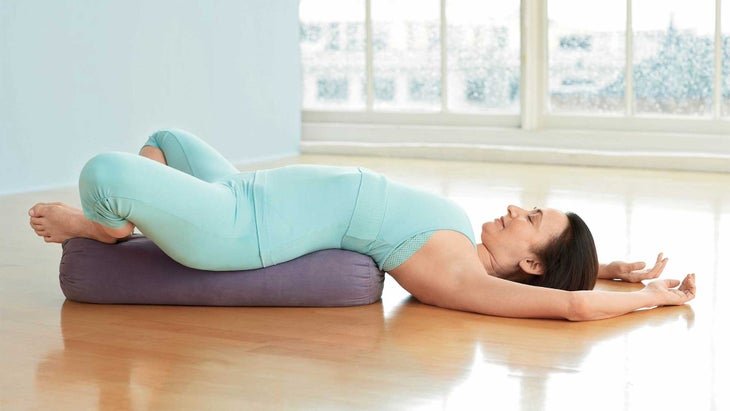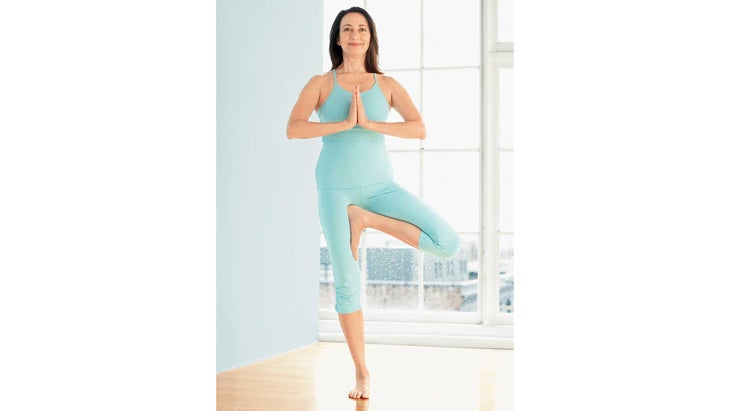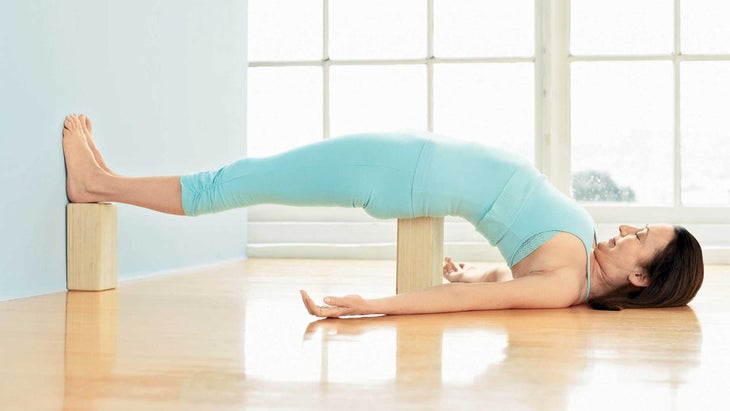Heading out the door? Read this article on the new Outside+ app available now on iOS devices for members! Download the app.

After menopause, you experience a drop in both estrogen and oxytocin (the love hormone). The decline of estrogen means postmenopausal bones can become brittle and joints can become stiff. The upside of this stage is that you’re done with the hormonal fluctuations that may have wreaked havoc on your emotional life. “Most women are elated that they are now free of the monthly changes, and they feel a renewed zest for life,” Brizendine says. For many, this comes at a time when the steep climb up the career ladder and the intensely demanding years of caring for children are over, and you can enjoy more time caring for yourself.
See also Yoga for Women’s Health: The Best Pose and Acupressure Point to Reduce Bloating
Adapting Your Practice for Postmenopause
Weight-bearing poses may help keep your bones strong and improve joint function. And a consistent asana practice can help maintain your range of motion and flexibility, but keep in mind that as your body changes, you might need to modify poses and use more props. Many women naturally gravitate toward quieter practices like meditation and pranayama in this phase of life. “We have given our lives to so many others for so long that now it’s just about coming home,” Northrup says. “The aging process doesn’t need to be about deterioration. That has always been a message of yoga.”
Real experience
Many yoginis are able to maintain athletic and dynamic practices well into their 60s. When de los Santos posed for these photos, she was 55 and taught at least 12 classes a week, and she enjoyed practicing advanced poses, like drop backs, (dropping back from a standing position into a full backbend). She can still do the same poses she did in her 20s, but after a lifetime of yoga, she’s keenly aware that that isn’t what really matters. “I know from experience that at any age or shape you can transform mind, body, and heart,” she says. She loves calming poses like Paschimottanasana (Seated Forward Bend) during times of stress. And when she can’t practice, she still cultivates yoga by being aware and appreciative. “I can honestly say that I feel bliss and happiness every day.”
See also The Truth About Forward Bends
3 Postmenopausal Yoga Poses You Need to Keep Bones and Joints Healthy
Tree Pose (Vrksasana)

Benefits: May help keep bones strong and builds confidence as you age.
Stand in Tadasana (Mountain Pose). Shift your weight onto your right foot and bend your left knee, bringing the left heel up to the inner right thigh. Press the heel into the thigh with toes pointing toward the floor. Bring your hands together in front of your heart. Press down into both heels and rise from the arches of your feet. Look down and make sure the center of your pelvis is over your right foot. Stay for 1 minute. To come out, release the leg to the floor and come back into Mountain Pose. Repeat on the other side.
Modified Reclining Bound Angle Pose (Supta Baddha Konasana)

Benefits: Keeps joints supple and promotes relaxation.
Sit on a bolster with two-thirds of it behind you and one-third in front of you. Lean backward so that your shoulders are off the bolster and on your mat, your midback is supported, and your hips are elevated on the bolster. Place your heels together and drop the knees gently away from each other and toward the floor. If the angle is too severe, support your shoulders with one to two blankets. Stay for 10–20 breaths. To come out, slowly bring your knees together and roll onto your side.
Bridge Pose (Setu Bandha Sarvangasana) at the Wall with Two Blocks

Benefits: Helps prevent low back pain, common at this time of life.
Place a block vertically against the wall and another one next to you. Lie on your back facing a wall with your knees bent and your arms outstretched at your sides, palms up. Roll your shoulders back and away from your head, expanding your chest. Raise your hips and chest up and support your back with your hands. Keep your head and shoulders flat on the floor, and lift your spine as high as you can so that one block fits under the fleshy part of your buttocks. Now stretch one leg at a time and place each heel on the block against the wall. Release your arms so that your hands reach just beyond the block under your buttocks. Breathe. Hold for 1 minute. To come out, bend your knees and bring your feet to the floor. Remove the block from under your sacrum and slowly roll down onto your back. Hug your knees to your chest.
About the Author
Nora Isaacs, a former editor at Yoga Journal, is the author of Women in Overdrive: Find Balance and Overcome Burnout at Any Age. Learn more about her writing and editing work at noraisaacs.com.
